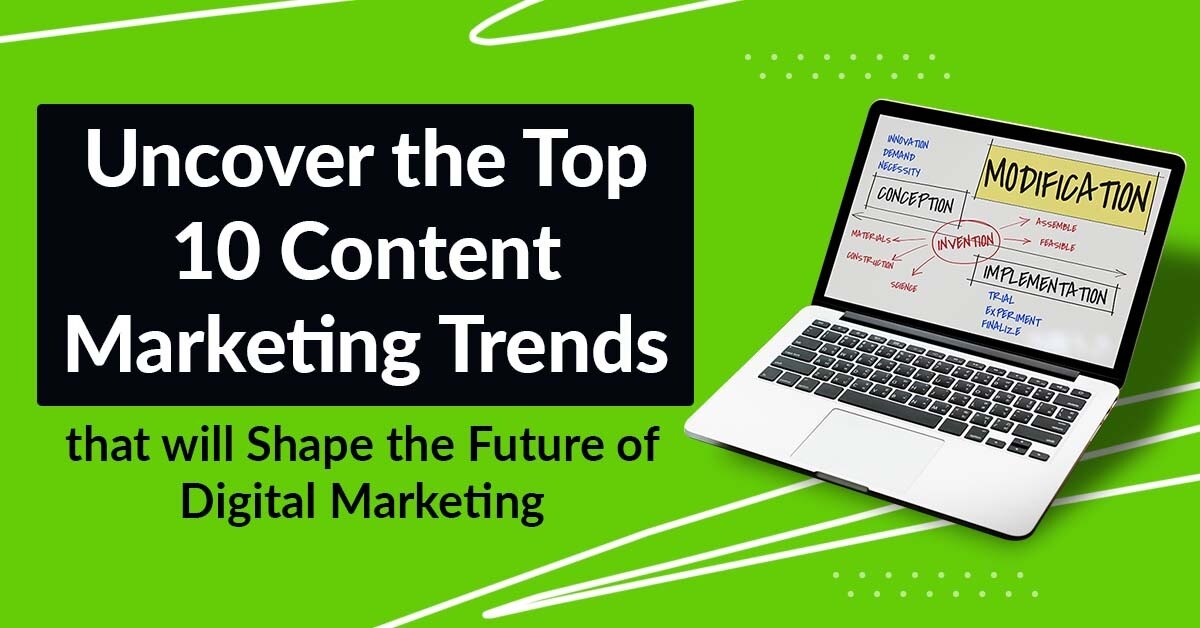Digital marketing is inherently dynamic, constantly evolving with:
- New technologies
- Changing consumer preferences
- Changing demands of the marketplace
This constant evolution requires businesses to remain agile, swiftly adapt to new platforms, tools, and trends, and adjust their strategies to stay relevant.
In 2025, content marketing will undergo a significant transformation, shaped by cutting-edge innovations, evolving audience expectations, and the push for more interactive and customized engagement. As businesses strive to remain competitive, understanding the latest trends in content marketing is crucial for staying ahead of the curve. Marketers must adapt their strategies to effectively engage their audiences and drive meaningful results.
For instance, the rise of voice search and immersive technologies like augmented reality has redefined how brands engage with their audiences. This dynamic landscape offers businesses unparalleled opportunities to reach global audiences, personalize interactions, and measure performance in real time. However, it also poses challenges, such as increased competition, the need for continuous learning, and navigating complex digital ecosystems.
Embracing change and innovating in digital marketing is crucial for businesses to thrive, stay competitive, and retain customer loyalty in today’s fast-paced economy.
This blog post will explore the top 10 content marketing trends that are expected to dominate in 2025. Exploring these trends in content marketing enables marketers to create precise, audience-driven strategies that amplify engagement, strengthen brand presence, and maximize returns.
Interactive and Immersive Content
Unlike conventional content that simply delivers information, interactive formats — like quizzes, polls, surveys, and interactive infographics — encourage users to take an active role in the content experience. This active participation not only enhances user engagement but also deepens the emotional connection with the brand, making the content feel more personal and relevant. By involving users directly, brands can foster a sense of ownership and interaction, making the experience more memorable and impactful.
By encouraging user participation, businesses can gather real-time insights about their audience’s preferences and behaviors, which can then be used to refine future marketing strategies. Interactive content also enhances the user experience by offering personalized and tailored interactions, increasing the likelihood of sharing and brand advocacy.
The next frontier in content marketing is the integration of immersive technologies like Virtual Reality and Augmented Reality. These technologies allow brands to offer highly engaging, interactive experiences that immerse users in a digital or mixed environment.
Virtual reality transports users into fully digital environments, making it perfect for immersive experiences like virtual tours, hands-on training, or showcasing products in an interactive way.
On the other hand, augmented reality overlays digital elements onto the real world, enhancing the user’s physical environment with interactive features. For example, AR can allow customers to try on products virtually or visualize how furniture would look in their homes.
In 2025, as VR and AR technologies evolve and become more widely available, brands will harness these tools to craft unique, unforgettable experiences that engage their audiences and make the boundary between the digital and physical realms even less distinct.
Personalized Content Experiences
Personalized content experiences are increasingly becoming a key focus in content marketing (one of the top content marketing strategies) as brands strive to deliver more tailored and relevant interactions with their audiences.
Personalization goes beyond simply addressing a customer by their name in an email; it involves using data and insights to create hyper-targeted content that aligns with the individual’s preferences, behaviors, and previous interactions with the brand. Hyper-targeted content takes personalization a step further by focusing on micro-segments or even individual users, delivering highly specific messages or offers that resonate deeply.
By leveraging data from customer touchpoints, such as website visits, social media engagement, purchase history, and search behavior, brands can craft precise recommendations, create ultra-targeted offers, and deliver content that feels uniquely relevant.
In 2025, AI and machine learning will refine content targeting even further, enabling brands to deliver precisely tailored, real-time content that resonates with each user’s unique preferences and interests.
Approximately 67% of small business owners and marketers rely on AI to support their content marketing and SEO efforts. This not only improves engagement, customer loyalty, and conversion rates but also allows businesses to foster stronger connections with their audience, making them feel truly understood and valued.
Video Content Continues to Dominate

Video content has become one of the most effective and engaging forms of communication, and its dominance is set to continue well into 2025. With the rise of short-form video platforms like TikTok, Instagram Reels, and YouTube Shorts, video has become the preferred format for capturing attention quickly and delivering messages in an easily digestible way.
As part of a broader visual content marketing strategy, brands will increasingly use videos to enhance storytelling, boost engagement, and create more immersive customer experiences.
As consumers lean more toward engaging and visually rich content, video has become the go-to format for both entertaining and educating audiences.
As part of effective video marketing strategies, in addition to short-form videos, live streaming is also gaining traction, allowing brands to interact with audiences in real time, fostering authenticity and deeper connections. With the rise in video consumption, businesses will focus on producing high-quality, shareable videos that address various points in the customer journey, guiding potential buyers from awareness to discovery and ultimately, conversion.
In 2025, video content will continue to be essential for driving engagement, as it not only captures attention but also delivers a memorable and impactful brand experience. As part of a comprehensive visual content marketing strategy, video will become even more integral in shaping customer perceptions. With the rise of shoppable videos, video will also play a crucial role in ecommerce by making the purchasing process seamless and direct.
Voice Search Optimization
Voice search optimization is becoming an essential component of digital marketing strategies as the use of voice-activated devices like the following continues to grow:
- Siri
- Google Assistant
- Alexa
As consumers increasingly turn to voice search for convenience, optimizing content for voice search has become necessary for maintaining visibility in search engine results.
Unlike traditional text searches, voice queries tend to be more conversational, often phrased in complete sentences or natural language. As a result, businesses need to adjust their SEO strategies to target long-tail keywords and question-based queries that people are likely to speak rather than type.
In 2025, voice search optimization will involve not only focusing on keywords but also ensuring content is structured in a way that answers questions directly and concisely, typically in a format that aligns with featured snippets or "position zero" in search results. Websites will also need to be mobile-friendly, as voice searches are commonly conducted on mobile devices.
By optimizing for voice search, businesses can improve their chances of appearing in voice-driven results, providing users with quick and relevant answers while staying ahead of this growing trend.
Social Commerce
Social commerce revolutionizes online shopping by allowing users to make purchases directly within their social media platforms, eliminating the need to visit a separate website and offering a smooth, integrated shopping experience. This trend has gained momentum as platforms develop shopping features, such as shoppable posts, in-app checkouts, and live-streamed product demos, to facilitate direct transactions.
Social commerce is transforming how consumers shop by making the purchasing process more social, interactive, and personalized. Social media content, including influencer collaborations, customer feedback, and user-generated posts, is becoming a key factor in shaping consumer decisions.
Social commerce taps into this behavior by allowing consumers to make purchases based on recommendations, trends, and peer reviews they see in their feeds. This also makes it easier for businesses to target highly specific customer segments, leveraging the rich data available on social platforms to deliver personalized product recommendations. A significant majority of B2B marketers (89%) use organic social media platforms for content distribution.
User-Generated Content

User-generated content includes any material, like photos, videos, reviews, or social media posts, created and shared by customers rather than the brand, showcasing authentic consumer experiences. UGC has become a powerful tool for building trust and authenticity because it reflects real-life experiences and opinions.
Beyond authenticity, there are several other benefits of user-generated content as well. UGC plays a key role in enhancing storytelling and brand narratives. By incorporating customer stories and experiences into their marketing, brands can create more relatable and engaging narratives that resonate deeply with their audience.
UGC-driven storytelling allows businesses to showcase how their products or services fit into the lives of real people, making their brand narrative more compelling, human, and impactful.
Consumers trust content created by their peers more than traditional brand messaging, as it feels more genuine and relatable. Brands are increasingly recognizing the value of UGC in their marketing strategies, as it helps to establish:
- Social proof
- Drive engagement
- Create a sense of community around the brand
The appeal of UGC lies in its ability to boost engagement and foster stronger relationships between brands and consumers. As part of emerging user-generated content trends, by featuring user-generated content in campaigns, brands can showcase authentic customer experiences, building a sense of trust and credibility. This type of content encourages more interaction, as customers feel validated and appreciated when their content is shared by the brands they support.
UGC is one of the most crucial content creation strategies that doesn't require heavy investment in production, making it a cost-effective way to generate high-quality marketing materials.
In 2025, brands will increasingly leverage UGC for storytelling, highlighting real-life success stories, testimonials, and product usage, all of which can drive conversions and improve brand perception.
Sustainability and Ethical Marketing
Customers are growing more mindful of how the brands they engage with affect the environment and society. In 2025, content marketers will focus on promoting sustainability and ethical business practices through their messaging.
Whether it’s highlighting eco-friendly products, supporting social causes, or showcasing corporate responsibility, brands will use content to communicate their commitment to making a positive impact. Authenticity will be key — consumers can spot inauthentic claims, so businesses must ensure their sustainability messages are backed by real action.
Content-Driven SEO

Rather than solely relying on keyword optimization and technical aspects like meta tags or backlinks, content-driven SEO prioritizes the creation of in-depth content that answers the questions, needs, and concerns of users.
In 2025, as search engines become smarter, they will continue to prioritize content that provides real value to users over content that is simply optimized for keywords. As the focus moves to value, businesses will prioritize creating in-depth, well-researched content like detailed articles, blogs, and guides that comprehensively answer the questions their audience is asking.
Marketers must shift their attention to producing content that not only performs well in search rankings but also fully addresses the questions and needs of the audience. This involves considering different types of intent, such as informational, transactional, and navigational, and tailoring content accordingly. For example, a searcher with informational intent may be looking for an in-depth tutorial, while someone with transactional intent might prefer a product comparison or buying guide.
When marketers design content based on the specific needs and goals of their audience, they can produce content that resonates more deeply, leading to:
- Higher engagement
- Improved conversion rates
- Greater customer satisfaction
Optimizing content for user experience is also an essential aspect of content-driven SEO. As mentioned in one of the earlier sections, websites must load quickly, be mobile-friendly, and provide easy navigation to retain visitors. As search engines like Google continue to emphasize factors like page experience, businesses that prioritize content quality and user satisfaction will see better rankings and greater engagement.
Evergreen Content with Frequent Updates
Evergreen content remains relevant and valuable over time, addressing topics that consistently interest and benefit audiences regardless of trends or seasonal shifts. In 2025, the focus on evergreen content will intensify, with brands recognizing its potential to attract consistent organic traffic and establish long-term authority. However, creating evergreen content alone is not enough — frequent updates will be crucial to maintaining its relevance and accuracy in a rapidly evolving digital landscape.
By regularly revisiting and refreshing evergreen articles, blog posts, guides, and videos, businesses can incorporate the latest statistics, insights, and best practices, ensuring the content remains useful and trustworthy.
Search engines also reward updated content, which can improve rankings and visibility. In addition, frequent updates allow brands to adapt to changing audience needs, algorithm updates, and market trends, keeping the content aligned with current expectations. This combination of evergreen value and timely updates ensures a continuous return on investment while fostering audience trust and engagement.
Cross-Channel Content Integration
In 2025, cross-channel content integration will be a key element of top content marketing strategies. This method guarantees a good and consistent experience for users across diverse channels like social media, email, websites, and mobile applications. Rather than treating each channel as an isolated touchpoint, cross-channel content integration focuses on delivering unified messaging and a consistent brand narrative, regardless of where the audience interacts with the brand.
For example, a campaign launched on Instagram can drive traffic to a detailed blog post, which in turn promotes a webinar shared through email marketing. This interconnected approach amplifies the impact of each piece of content, maximizes reach, and improves audience engagement.
By aligning content themes, tone, and objectives across all platforms, brands can create a more holistic customer journey. Integrated analytics and tracking systems allow businesses to evaluate the performance of their cross-channel strategies, facilitating improved optimization and offering users a more tailored experience.
Strategies to Implement These Trends in Content Marketing Effectively
Successfully leveraging the top content marketing strategies of 2025 requires a strategic approach that aligns with your brand’s goals, audience preferences, and market dynamics. Here’s how to implement these trends in content marketing effectively:
Prioritize Audience-Centric Content
Understanding your audience is critical for implementing the digital marketing trends of 2025 like hyper-targeted and personalized content. Conduct in-depth audience research to identify their preferences, pain points, and behaviors. Use this data to craft tailored content that speaks directly to their needs and aspirations.
Focus on Regular Content Updates
Keep evergreen content fresh and relevant by scheduling regular updates. Monitor industry developments and incorporate the latest insights into your content. Use tools like Google Trends or analytics platforms to identify outdated information and optimize it for better performance.
Build a Cross-Channel Content Plan
To implement cross-channel integration effectively, start with a unified content strategy that outlines how each channel will complement the others. Develop content that can be repurposed and shared seamlessly across platforms while maintaining consistent messaging. Ensure all teams — social media, email marketing, and content creation — are aligned and equipped with shared goals and resources.
Invest in Technology and Tools
Adopting AI, machine learning, and data analytics tools can supercharge your content marketing efforts. Use AI to analyze audience behavior, generate personalized recommendations, and create hyper-targeted content. Machine learning can also help identify trends and optimize campaigns in real-time, ensuring your strategies remain relevant.
Embrace UGC and Storytelling
Encourage your customers to share their stories through reviews, photos, or social media posts. Showcase user-generated content in your campaigns to build trust and authenticity. Integrate these stories into your brand narrative to create relatable, impactful messaging.
Leverage Analytics to Measure Success
Set clear KPIs to track the effectiveness of your campaigns, whether it’s website traffic, engagement rates, or conversions. Use analytics tools to monitor performance across channels and refine strategies based on the data.
Stay Agile and Experiment
The digital landscape is dynamic, so remain open to testing new approaches and formats. Conduct A/B testing to determine what resonates best with your audience, and be prepared to pivot based on emerging marketing trends or feedback.
Predictions for the Future of Content Marketing
Brands will focus on delivering highly relevant, data-driven content tailored to individual preferences. Interactive formats such as quizzes, polls, and augmented experiences will enhance audience engagement.
Sustainability-focused storytelling will gain prominence as consumers prioritize ethical and transparent brands. Additionally, integrating content seamlessly across multiple channels will be crucial for providing a unified customer experience.
As automation and AI tools evolve, marketers will rely on real-time analytics to refine campaigns, ensuring content remains impactful, adaptive, and aligned with shifting consumer behaviors.
AI tools for content marketers will assist in optimizing content creation, distribution, and performance tracking, making campaigns more efficient and targeted. These emerging shifts will redefine the future of content marketing, driving it towards greater personalization, engagement, and adaptability to meet the evolving demands of audiences.
Final Thoughts
To stay competitive, you’ve got to keep up with the latest trends because content marketing is constantly evolving. By embracing emerging marketing trends, innovative technologies, personalizing content, and delivering more engaging and immersive experiences, businesses can better connect with their audiences in 2025. Whether it's through AI-powered tools, interactive content, or a stronger focus on sustainability, the future of content marketing is filled with exciting opportunities for those willing to innovate and adapt.
You can also reach out to a content marketing agency to help navigate these changes and implement effective strategies.










